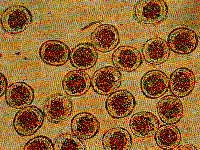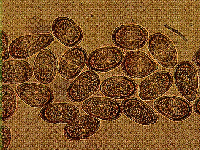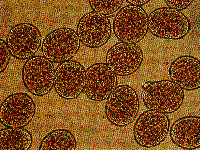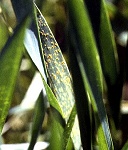

| March 1, 2003 |
 |
|---|
Leaf, Stem and Stripe Rust
Most producers are familiar with stem rust and leaf rust which can cause extensive damage. The fungi which cause these diseases, when left unchecked in favorable environmental conditions, can result in the loss of both grain yield and quality. The development of the fungi is impacted by water and temperatures. When favorable environmental conditions exist the life cycle for the spores can occur in 7 to 14 days. Frequent heavy dew, light rain, or high humidity and temperatures generally in the range of 59 to 77 degrees Fahrenheit (F) are ideal for rust development. Pustules form on the surface of the plant parts and contain thousands of microscopic spores. The pustules erupt releasing the new urediospores into the air and they are dispersed by the wind.
Urediospores germinate in rain or dew and infect leaves within 6 to 8 hours after settling on the plant surface. The infection element of the fungi is capable of penetrating into a plant directly and will enter through the plant breathing pores or wounds. Plants have many microscopic breathing pores called stomata on the surface of the leaves. This is a common spot of infestation. Once the fungal infestation element becomes established inside the plant, the invaded tissue gradually dies as the urediniospores develop. Shown in Figure 1, is the urediospores of leaf, stem and stripe rust. Rust spreads by wind blowing urediospores from plant to plant and from field to field until the crop matures.
 Leaf Rust |
 Stem Rust |
 Stripe Rust |
|---|
Leaf rust (Puccinia recondita)
Leaf rust is blown into our area by prevailing winds.  Winds can carry rust spores for great distances. The disease can develop rapidly at temperatures of 52 to 72 degrees F, when moisture is not a limiting factor. The optimum temperature for sporulation and infestation is approximately 70 degrees F and infestation can occur within four hours if leaves are wet. The spores can initially infect and produce pustules where the raindrops have collected at leaf axils and tips. New pustules erupt within 7 to 10 days. Rust development is slowed drastically with cooler temperatures or a shorter leaf wetting period. At 60 degrees F a wetting period of 8 to 10 hours is necessary. Very wet conditions reduce spore dispersal. Epidemics generally develop when favorable moisture exists and temperatures are above 60 degrees F.
Winds can carry rust spores for great distances. The disease can develop rapidly at temperatures of 52 to 72 degrees F, when moisture is not a limiting factor. The optimum temperature for sporulation and infestation is approximately 70 degrees F and infestation can occur within four hours if leaves are wet. The spores can initially infect and produce pustules where the raindrops have collected at leaf axils and tips. New pustules erupt within 7 to 10 days. Rust development is slowed drastically with cooler temperatures or a shorter leaf wetting period. At 60 degrees F a wetting period of 8 to 10 hours is necessary. Very wet conditions reduce spore dispersal. Epidemics generally develop when favorable moisture exists and temperatures are above 60 degrees F.
Leaf rust pustules (uredia) develop primarily on the upper surface of leaf blades. Pustules are round to oval, about 1/50 inch in diameter (about the size of a pinhead), and filled with thousands of orange-red spores (urediospores). These spores are easily dislodged by the wind or rubbing and accumulate as red dust on hands, clothing, and machinery. They may occur on stems but are most common on the upper surface of the leaves. Rust increases water loss from leaves so they die prematurely.
Since the leaf rust loss results from the early kill of the upper two wheat leaves, the faster an epidemic develops, the greater the loss. Loss can be roughly predicted by matching severity on the flag leaf with growth stage. If the flag leaf is severely damaged prior to the milk stage, the approximate loss in yield is 25 to 40 percent. If the disease damages the flag leaf between the soft and hard dough stages of the developing wheat, yield losses are usually less than 10 percent.
Stem rust (Puccinia graminis)
A wave of infection usually advances northward by wind-blown spores released from infected wheat or barley plants.  Stem rust usually enters our area in late March to mid-April depending on weather conditions and the extent of disease development on cereal crops south of us. The disease usually appears on plants in early spring.
Stem rust usually enters our area in late March to mid-April depending on weather conditions and the extent of disease development on cereal crops south of us. The disease usually appears on plants in early spring.
After infection, pustules form in 7-10 days. The pustules break open, releasing masses of spores that can infect surrounding plants. Temperatures of 68 to 77 degrees F favor stem rust development. Rust spots are very small, circular or elongated, and vivid orange-red in color. Later in the year, the rust pustules darken because of the production of dark-brown-black spores which are the overwintering stage of the rust.
Infected plants usually produce fewer tillers, set fewer seeds per head, and yield small shrivelled seeds with poor milling quality and food value.
Stripe rust (Puccinia striiformis)
 Stripe rust is blown into our area by prevailing winds. Winds can carry rust spores for great distances. The disease can develop rapidly when moisture is not limited. Urediospores are yellow to orange in color and have an elongated shape. Urediospores lose their viability rapidly at temperatures above 59 F. Germination is best between 41 and 59 F, with limits at 32 and 68 F. Infection may occur through the winter, since the mycelium remains viable to 23 F. The disease develops most rapidly between 50 and 59 F when intermittent rain or dew occurs. Many disease cycles may take place in one season, since the time between infection and sporulation under optimal conditions is about 8 days. Cool, wet falls; mild, open winters; and long, cool, wet springs favor stripe rust.
Stripe rust is blown into our area by prevailing winds. Winds can carry rust spores for great distances. The disease can develop rapidly when moisture is not limited. Urediospores are yellow to orange in color and have an elongated shape. Urediospores lose their viability rapidly at temperatures above 59 F. Germination is best between 41 and 59 F, with limits at 32 and 68 F. Infection may occur through the winter, since the mycelium remains viable to 23 F. The disease develops most rapidly between 50 and 59 F when intermittent rain or dew occurs. Many disease cycles may take place in one season, since the time between infection and sporulation under optimal conditions is about 8 days. Cool, wet falls; mild, open winters; and long, cool, wet springs favor stripe rust.
For more information about stripe rust and fungicide recommendations (click here).
Freeze Injury In Small Grains
In April of 1997, we had a cold front with freezing temperatures come through our region which reduced wheat yields by about 25 percent. Several agents were involved in checking wheat fields for injury and were asked to make recommendations concerning the best use of the wheat crop. As the wheat starts to grow in the spring it becomes more sensitive to low temperatures. It only takes about two hours of cold temperatures to injur the wheat. With the recent cold temperatures that occurred February 24 & 25, 2003, you may want to review the information on freeze injury in wheat (click here).
The following counties have made their cottonseed requests for 2003: Midland, Martin, Glasscock, Reagan, Upton, Nolan, and Scurry. I will be calling companies soon to make seed request.
The information to be presented at the upcoming Cotton Conference in San Angelo, Texas, on March 25, 2003, will be useful to agents in cotton producing counties. For agents that want to know more about cotton plant growth and development, an introductory training course will be conducted during the conference. If you know of others that need to attend this introductory training on cotton plant growth and development, please let me know.
On Monday, March 10, there will be a training conducted at Abilene for producers needing to obtain a Private Applicators License. For more details and to register for the meeting call Gary Bomar at (915) 672-6048.
An Agricultural Waste Pesticide Collection Event has been scheduled for April 9, 2003 at Wall CO-OP Fertilizer Facility. Collection of materials will be from 8:00 a.m. to 1:00 p.m. For more information go to the TNRCC Website (http://www.tnrcc.state.tx.us/exec/oppr/agwaste/agwaste.html).
Several of you conduct grain sorghum and forage sorghum variety tests each year. Sometimes these demonstration plots are short fused with varieties needed quickly. By selecting varieties from the same maturity group you will save yourself a lot of problems. Two main problems that can be avoided is timing insecticide applications and harvesting the plot within a short time frame.
From the variety tests conducted over the past five years, we have found that producers management practices have the greatest impact on the quality of forage being harvested as hay or forage. Before spending a lot of time and effort on a variety test you need to select a producer that has good management practices.
Several agents indicated that it would be useful to have the weeds grouped by bloom color. In an attempt to get started, compiled is a list of weeds that will have yellow blooms in the spring. Each small picture is linked to a larger picture. Let me know if this is what you asked for.
 March 3, District 7 Headquarters, Office Conference
March 3, District 7 Headquarters, Office Conference
 March 3 - 5, Travis County, Cotton Physiology Work Group
March 3 - 5, Travis County, Cotton Physiology Work Group
 March 6 & 7, Harris County, Texas 4-H Foundation Meeting
March 6 & 7, Harris County, Texas 4-H Foundation Meeting
 March 21, Tom Green County, Professional Ag Workers
March 21, Tom Green County, Professional Ag Workers
 March 21, Tom Green County, Southern Rolling Plains Cotton Growers Asso.
March 21, Tom Green County, Southern Rolling Plains Cotton Growers Asso.
 March 25, Tom Green County, Concho Valley Cotton Conference
March 25, Tom Green County, Concho Valley Cotton Conference
 April 1, Tom Green County, Soil and Soil Fertility
April 1, Tom Green County, Soil and Soil Fertility
 April 2, Nolan County, Multi-County Cotton Conference
April 2, Nolan County, Multi-County Cotton Conference
 April 7, District 7 Headquarters, Office Conference
April 7, District 7 Headquarters, Office Conference
 April 9, Tom Green County, Pesticide Disposal at Wall, Texas
April 9, Tom Green County, Pesticide Disposal at Wall, Texas
 April 10, Teleconference, District 6
April 10, Teleconference, District 6
 April 11 - 13, Brazos County, Parents Weekend at Texas A&M
April 11 - 13, Brazos County, Parents Weekend at Texas A&M
 April 15, Tom Green County, Ag Committee Meeting
April 15, Tom Green County, Ag Committee Meeting
 April 18, Tom Green County, Professional Ag Workers
April 18, Tom Green County, Professional Ag Workers
 April 21 - 24, Grimes County, Texas 4-H Foundation Meeting
April 21 - 24, Grimes County, Texas 4-H Foundation Meeting
 April 28, Burnett County, CEU Course
April 28, Burnett County, CEU Course
 April 29 - 30, Brown County, Professional Board Meeting
April 29 - 30, Brown County, Professional Board Meeting
Sincerely,
|